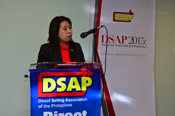1st GMM Guest Speaker from DOF
Maria Theresa Habitan of the Department of Finance Discusses About
the Developments on the Philippine Economy
Maria Theresa Habitan of the Department of Finance illustrated in her presentations during the 1st DSAP GMM, how the Philippines, once known as the “Sick Man of Asia” has transitioned to one of the fastest growing economies.
As proof of this, on average, she mentioned that real GDP has risen above 6.3% in the last five years. This occurred while a global financial crisis ravaged US, Japan and Europe. Last year, the Philippines grew 7.2%, the fastest in ASEAN. In 2014, GDP growth reached 6.1%, again the fastest in ASEAN.
Growth she said, is broad-based with industry and services paving the way. Industry was the star performer — growing by an average of 7.5% since 2010. Manufacturing led the industry subsectors at 7.9%; as it benefited from liberalization in the ‘80s before AEC was conceived. Globally, the Philippines is now number 4 in shipbuilding and number 7 in electronics. Services was a close second at 6.5%.
Habitan further elaborated that the double-digit growth of technology-aided services exports contributed to the robust expansion. We are now the BPO capital in the world, second to India.
She added that OF (Overseas Filipino) remittances took the upper hand in 2012 as Gross National Income (GNI) rose by 6.6% in 2012, 7..6% in 2013 and 6.4% in 2014. Studies have shown the strong correlation between remittances and consumption.
Meanwhile on the downside, she mentioned that agriculture grew by a dismal 1.6% as it was hounded by weather problems.
She further stresses that the weak BOP position that trapped the economy into a boom-bust cycle from the ‘60s to late ‘90s is gone. “We have had a surplus in both the BOP and current account for more than 10 years (11 for current account and 12 for BOP). We no longer need to borrow from outside to sustain investments. We are now a net creditor nation — lending instead of borrowing from the IMF” she said.
“Strong balance-of-payments performance was primarily buoyed by overseas Filipino remittances which have turned out to very resilient, defying economic recession in the Europe and North America. OFW remittances is the primary reason for this reversion from a debt-mired economy to one that is among the fastest growing in Asia. The share in GDP ihas plateaud, implying that the economy is more reliant on othere growth drivers”, she added.
She also attributed the negative BOP in 2014 due to QE tapering by the US Fed which led to portfolio investments pulling out in January 2014.
Foreign investments jumped on improved confidence and credit upgrades. Although the numbers are not yet that significant compared with Asian neighbors, foreign investors are beginning to see the strengths of the Philippines, as FDI jumped 61.6% during the first 11 months of 2014. Reversals of portfolio investments in the first quarter of 2014 due to the Fed tapering did not hurt as much compared to our neighbors did primarily due to high GIR and the fast recovery during the last few months.
This is the reason why the economy remains strong. Foreign currency reserves reached US$81.3 billion as of February 2015, equivalent to 10.4 months of import of goods and services, among the highest in Asia (next to HK and China). Our economy weathered successfully the Fed tapering with just a temporary decline in reserves.
The peso remains strong even with stormy international weather. Despite QE tapering in 2014, the depreciation was manageable.
In support of strong fundamentals, interest rates have trended down to their lowest levels in history. Inflation has similarly decelerated. Recently, there was a slight uptick due to food prices, however, as rice harvest was adversely affected by catastrophic typhoons. Still inflation is within projected levels.
Growth is backed up by our own savings—a large percentage of which is in foreign currency. And investments continue to lag behind.
Fiscal performance continues to be within targeted levels. Revenue and tax effort continue to rise. The debt ratio has continued to drop within NG debt-GDP ratio dropping below 50% and general government debt below 40%. The problem has swung to the opposite —- government spending is too low and too slow.
Our tax effort still pales in comparison to 16% average in ASEAN. Our non-tax revenue/GDP ratio is only 1.5% — low compared with 4% for ASEAN. Habitan said that there is a need to improve tax collection and enhance the efficiency of GOCCs.
The decline in debt and debt service has opened up fiscal space for more productive spending and this she mentioned, should allow the public sector to boost infrastructure spending to 5% of GDP by 2016. Other observations and suggestions she shared during her report include the following;
- The private sector should take advantage of the rapidly growing economy to hone its competitiveness and expand its market. It should invest after studying the opportunities available. It should maintain the appropriate scale of operations that minimizes its costs and optimizes gains.
- It should continue to stay competitive, reduce costs where possible and improve on product quality. (Your) ears should stay glued to (your )markets — adopt to changing needs.
- Look for the cheapest sources of inputs. The ASEAN market is a huge source of supply.
- Aim at the market that is most advantageous, considering your advantages.
- The ASEAN Economic Community is about to be launched with unfettered borders. A market of 625 million with purchasing power of US$2.5 trillion, growing by 5% a year, should be a very attractive option.
- Remaining local with a market of 100 million and a purchasing power of US$285 million should also be not bad.
Lastly, she said that we should pay our taxes willingly and promptly. She ended with a quote that a philosopher once said — “Taxes are our contribution to a civilized society.”
